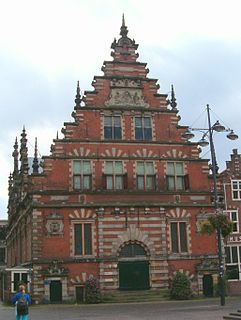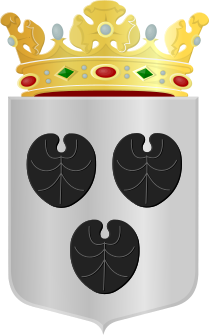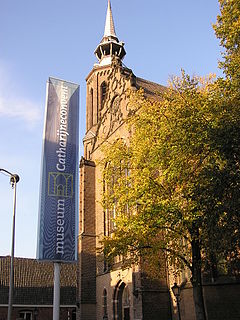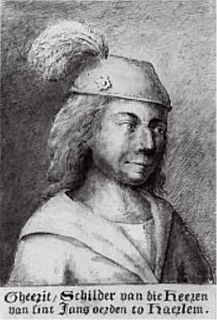
Lieven de Key was a famous Dutch renaissance architect in the Netherlands, mostly known today for his works in Haarlem.

Haarlem is one of the cities in the Netherlands that has a number of hofjes. Some of them are even still in use with boards of regents. Many of these are members of the Stichting Haarlemse Hofjes. The word 'hofje' just means small garden, because the hofjes are generally small houses grouped around a community kitchen garden with a water pump. Often they were attached to a larger field for bleaching linen or growing orchards, but today those fields have been long used for city expansion and only the central gardens can still be seen.

Albert van Ouwater was one of the earliest artists of Early Netherlandish painting working in the Northern Netherlands, as opposed to Flanders in the South of the region.
The Dutch School were painters in the Netherlands from the early Renaissance to the Baroque. It includes Early Netherlandish (1400–1500) and Dutch Renaissance (1500–1584) artists active in the northern Low Countries and, later, Dutch Golden Age painting in the United Provinces.

The Master of Alkmaar was a Dutch painter active around Alkmaar at the beginning of the sixteenth century. His name is derived from a series of panel paintings from the church of Saint Lawrence in that city, dated to 1504 and showing the Seven Works of Mercy; they are currently in the Rijksmuseum in Amsterdam.
Joan Albert Ban (1597–1644) was a Dutch Catholic priest and composer.

Egmond Abbey or St. Adalbert's Abbey is a Benedictine monastery of the Congregation of the Annunciation between Egmond aan den Hoef and Bakkum in Egmond-Binnen in the municipality of Bergen in the Dutch province of North Holland. Founded in 920-925 and destroyed in the Reformation, it was re-founded in 1935 as the present Sint-Adelbertabdij, in the Diocese of Haarlem.

Gerdina Hendrika Kurtz (1899–1989) was a Dutch historian, writer and archivist. She published under the name, G.H. Kurtz.

Het Dolhuys is a national museum for psychiatry in Haarlem, Netherlands. The museum was founded in 2005 in the newly renovated former old age home known as Schoterburcht, located just across the Schotersingel from the Staten Bolwerk park. The whole complex is much older than that however, having been a hospital for centuries known as the Leproos-, Pest- en Dolhuys.

The Haarlem Guild of Saint Luke was first a Christian, and later a city Guild for a large number of trades falling under the patron saints Luke the Evangelist and Saint Eligius.

The Sint Janskerk in Gouda, the Netherlands, is a large Gothic church, known especially for its stained glass windows, for which it has been placed on the UNESCO list of Dutch monuments.

Museum Haarlem is a city museum on Groot Heiligland 47, Haarlem, Netherlands, located across the street from the Frans Hals Museum. It shares its front door with the ABC Architectuurcentrum Haarlem, which is located next door. The museum is devoted to presenting and preserving the cultural history of Haarlem and the surrounding region.
Janskerk or St. John's Church may refer to:

Master of the Figdor Deposition (1480–1500), was an Early Netherlandish painter.
The following is a timeline of the history of the municipality of Haarlem, Netherlands.

The Holy Kinship is a circa 1495 oil on panel painting of Holy Kinship by the workshop of the renaissance artist Geertgen tot Sint Jans in the collection of the Rijksmuseum.

The Adoration of the Magi is a circa 1480-1485 oil on panel painting of the Adoration of the Magi by the Renaissance artist Geertgen tot Sint Jans in the collection of the Rijksmuseum.

The Church of Saint John the Baptist is a Roman Catholic church located in Sint-Jans-Molenbeek, a municipality of Brussels, Belgium. Designed by Joseph Diongre and built in 1931 in Art Deco style, it is one of three major churches in Brussels made of reinforced concrete. The church and the Catholic parish it belongs to gave their name to the municipality.






























